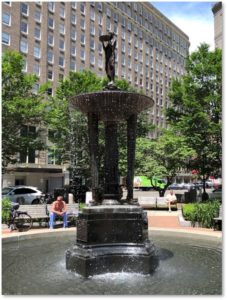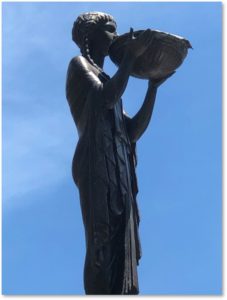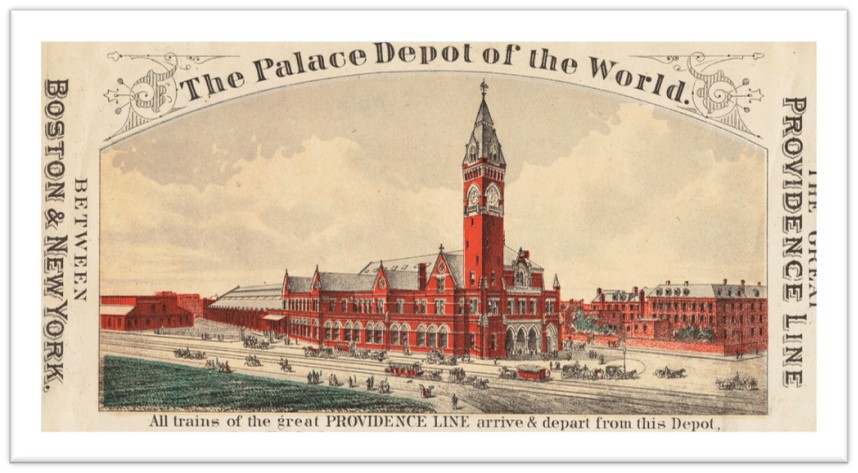 The first time I saw the Statler Fountain in Statler Park, both it and Statler Park had fallen on hard times. Although the city had started to clean up and move out of its long post-war depression by the eighties, those efforts had not reached this far. I thought what a shame it was that such a small gem of a park had scruffy plantings and the fountain’s basin had been turned into a planter. Litter and trash abounded.
The first time I saw the Statler Fountain in Statler Park, both it and Statler Park had fallen on hard times. Although the city had started to clean up and move out of its long post-war depression by the eighties, those efforts had not reached this far. I thought what a shame it was that such a small gem of a park had scruffy plantings and the fountain’s basin had been turned into a planter. Litter and trash abounded.
Wow, have things changed since then.
While still small, just a quarter acre, Statler Park now provides a green oasis near Park Square and the fountain sparkles with Art Deco grace.
Boston’s Made Land
The triangular park bordered by Stuart Street, Church Street and Columbus Avenue has an interesting history. Prior to the land-making that created modern Boston, it faced the shoreline where British Regulars landed before marching to the battles of Concord and Lexington. During the 17th Century, this site marked the transition from the waters of the Back Bay to the Shawmut Peninsula.
In the 1820s, the city filled the area known as the Church Street District with household ashes from burning coal and trash, pushing the waterfront further away. Today the site lies on the Columbus Avenue Corridor at the transition between Back Bay, the South End and the Public Garden. That connection point drove the park’s triangular shape, which is echoed in the fountain’s design.
Park Square and Dynamite
The made land held Clarence Blackall’s Selwyn Theater, which burned down in 1873, and the depot for the Boston and Providence Railroad built by Peabody and Stearns in 1872. When that railroad became one of four to consolidate at South Station in 1899, the depot lost its main function and was dynamited in 1910. Imagine watching the Ruskinian Gothic building’s massive clock tower come down. The lot remained vacant until 1925.
Ellsworth Milton Statler acquired the 57,561 square foot parcel for $450,000 and began work on his Boston hotel, which rose over the old track platforms, and an office building in 1925. With a little help from Mayor James Curley, he was able to make the 14-story hotel the tallest building in Boston by 30 feet. It cost $14 million and opened on March 10, 1927.
Since 1976, the D.L. Saunders Companies and the Boston Park Plaza, LLC, has owned and operated the former Statler-Hilton Hotel and Statler Office Building as a family. They have been renamed the Boston Park Plaza Hotel and the Park Plaza Office Building. At the same time, the Donald and Roger Saunders Family began a more than 30-year Park Partnership with the City of Boston to maintain and care for Statler Park.
The Statler Fountain
Statler Park was created by Ellsworth Milton Statler, founder of the Statler Hotel chain, and given to the City of Boston in 1930. An interesting person and an innovative businessman, he also donated the fountain, with its art deco sculpture, to anchor the center of the park. American sculptor Ulysses Anthony Ricci (1888-1960) created the Fountain Figure in bronze around 1912.
 The fountain is shaped like a Roman tripod. A woman with braided hair in classical robes stands on a ball amid four curled leaves in the center of the upper basin. She holds a cup from which water drips into the basin and then down in a sparkling curtain to the lower basin, which is rimmed in granite.
The fountain is shaped like a Roman tripod. A woman with braided hair in classical robes stands on a ball amid four curled leaves in the center of the upper basin. She holds a cup from which water drips into the basin and then down in a sparkling curtain to the lower basin, which is rimmed in granite.
Signs of the zodiac in relief decorate the lip of the cup. The edge of the upper basin is decorated with egg-and-dart molding that channels the water into strings of beads.These liquid strings are so fine they often don’t show up at all on pictures.
Bas-relief designs decorate the tripod legs supporting the upper basin, which terminate in lion’s paws.The spiral-grooved central column has a matching base of overlapping leaves.The fountain stands on a triangular black marble base in the center of the lower basin.
Renovation and Restoration
Today, Statler Park offers a lovely green oasis in Park Square. Its benches and plantings invite one to sit and enjoy the fountain’s sparkling curtain and the music of the water dripping into the basin. It even has its own Facebook page which lists public activities in and around the park.

